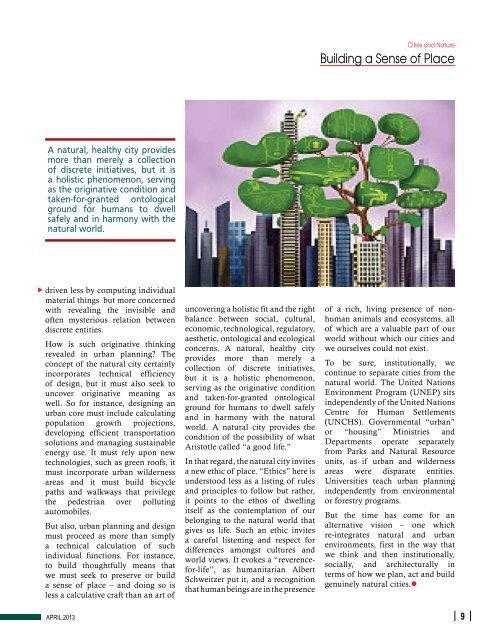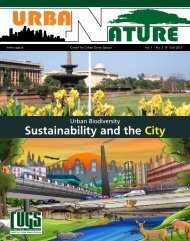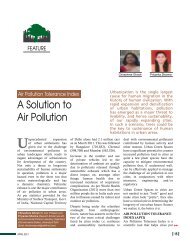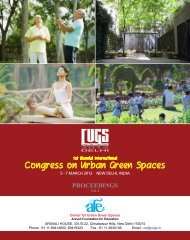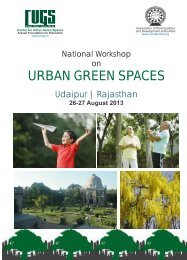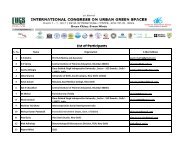Building a Sense of Place - Center for Urban Green Spaces
Building a Sense of Place - Center for Urban Green Spaces
Building a Sense of Place - Center for Urban Green Spaces
You also want an ePaper? Increase the reach of your titles
YUMPU automatically turns print PDFs into web optimized ePapers that Google loves.
Cities and Nature<br />
<strong>Building</strong> a <strong>Sense</strong> <strong>of</strong> <strong>Place</strong><br />
A natural, healthy city provides<br />
more than merely a collection<br />
<strong>of</strong> discrete initiatives, but it is<br />
a holistic phenomenon, serving<br />
as the originative condition and<br />
taken-<strong>for</strong>-granted ontological<br />
ground <strong>for</strong> humans to dwell<br />
safely and in harmony with the<br />
natural world.<br />
driven less by computing individual<br />
material things but more concerned<br />
with revealing the invisible and<br />
<strong>of</strong>ten mysterious relation between<br />
discrete entities.<br />
How is such originative thinking<br />
revealed in urban planning? The<br />
concept <strong>of</strong> the natural city certainly<br />
incorporates technical efficiency<br />
<strong>of</strong> design, but it must also seek to<br />
uncover originative meaning as<br />
well. So <strong>for</strong> instance, designing an<br />
urban core must include calculating<br />
population growth projections,<br />
developing efficient transportation<br />
solutions and managing sustainable<br />
energy use. It must rely upon new<br />
technologies, such as green ro<strong>of</strong>s, it<br />
must incorporate urban wilderness<br />
areas and it must build bicycle<br />
paths and walkways that privilege<br />
the pedestrian over polluting<br />
automobiles.<br />
But also, urban planning and design<br />
must proceed as more than simply<br />
a technical calculation <strong>of</strong> such<br />
individual functions. For instance,<br />
to build thoughtfully means that<br />
we must seek to preserve or build<br />
a sense <strong>of</strong> place – and doing so is<br />
less a calculative craft than an art <strong>of</strong><br />
uncovering a holistic fit and the right<br />
balance between social, cultural,<br />
economic, technological, regulatory,<br />
aesthetic, ontological and ecological<br />
concerns. A natural, healthy city<br />
provides more than merely a<br />
collection <strong>of</strong> discrete initiatives,<br />
but it is a holistic phenomenon,<br />
serving as the originative condition<br />
and taken-<strong>for</strong>-granted ontological<br />
ground <strong>for</strong> humans to dwell safely<br />
and in harmony with the natural<br />
world. A natural city provides the<br />
condition <strong>of</strong> the possibility <strong>of</strong> what<br />
Aristotle called “a good life.”<br />
In that regard, the natural city invites<br />
a new ethic <strong>of</strong> place. “Ethics” here is<br />
understood less as a listing <strong>of</strong> rules<br />
and principles to follow but rather,<br />
it points to the ethos <strong>of</strong> dwelling<br />
itself as the contemplation <strong>of</strong> our<br />
belonging to the natural world that<br />
gives us life. Such an ethic invites<br />
a careful listening and respect <strong>for</strong><br />
differences amongst cultures and<br />
world views. It evokes a “reverence<strong>for</strong>-life”,<br />
as humanitarian Albert<br />
Schweitzer put it, and a recognition<br />
that human beings are in the presence<br />
<strong>of</strong> a rich, living presence <strong>of</strong> nonhuman<br />
animals and ecosystems, all<br />
<strong>of</strong> which are a valuable part <strong>of</strong> our<br />
world without which our cities and<br />
we ourselves could not exist.<br />
To be sure, institutionally, we<br />
continue to separate cities from the<br />
natural world. The United Nations<br />
Environment Program (UNEP) sits<br />
independently <strong>of</strong> the United Nations<br />
Centre <strong>for</strong> Human Settlements<br />
(UNCHS). Governmental “urban”<br />
or “housing” Ministries and<br />
Departments operate separately<br />
from Parks and Natural Resource<br />
units, as if urban and wilderness<br />
areas were disparate entities.<br />
Universities teach urban planning<br />
independently from environmental<br />
or <strong>for</strong>estry programs.<br />
But the time has come <strong>for</strong> an<br />
alternative vision – one which<br />
re-integrates natural and urban<br />
environments, first in the way that<br />
we think and then institutionally,<br />
socially, and architecturally in<br />
terms <strong>of</strong> how we plan, act and build<br />
genuinely natural cities.•<br />
April 2013<br />
9


